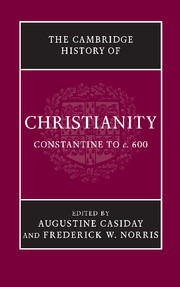Book contents
- Frontmatter
- Introduction
- Part I Christianity: Regional Developments
- Part II Christianity Contested
- 5 Religious dynamics between Christians and Jews in late antiquity (312–640)
- 6 Christianity and paganism, I: Egypt
- 7 Christianity and paganism, II: Asia Minor
- 8 Christianity and paganism, III: Italy
- 9 Christianity and paganism, IV: North Africa
- 10 The intellectual debate between Christians and pagans
- 11 Christianity and Manichaeism
- 12 Heresiology: The invention of ‘heresy’ and ‘schism’
- Part III Christian Culture and Society
- Part IV Christian Beliefs and Practices
- Index
- Map 1 The Roman empire, c. 400">
- References
8 - Christianity and paganism, III: Italy
from Part II - Christianity Contested
Published online by Cambridge University Press: 28 March 2008
- Frontmatter
- Introduction
- Part I Christianity: Regional Developments
- Part II Christianity Contested
- 5 Religious dynamics between Christians and Jews in late antiquity (312–640)
- 6 Christianity and paganism, I: Egypt
- 7 Christianity and paganism, II: Asia Minor
- 8 Christianity and paganism, III: Italy
- 9 Christianity and paganism, IV: North Africa
- 10 The intellectual debate between Christians and pagans
- 11 Christianity and Manichaeism
- 12 Heresiology: The invention of ‘heresy’ and ‘schism’
- Part III Christian Culture and Society
- Part IV Christian Beliefs and Practices
- Index
- Map 1 The Roman empire, c. 400">
- References
Summary
The spread of Christianity in Italy – as elsewhere throughout the empire – was greatly aided by the imperial support it received from the time of the emperor Constantine’s conversion. It was, after all, in Italy (near the Milvian Bridge just north of Rome, to be precise) that Constantine in later life claimed to have experienced his vision that he came to see as a sign of his victory from the god of the Christians. Beginning with this emperor and continuing largely without interruption for the next centuries, imperial support, monies and privileges flowed into the Christian community and its institutions in Italy. In particular, the episcopate benefited from imperial largesse and attention. All throughout Italy’s cities, bishops came to take on increasingly prominent social and political roles over the course of the fourth and fifth centuries.
It would be misleading, however, to see the spread of Christianity and the concomitant demise of polytheism in Italy in the years 300–600 as predicated solely on imperial or episcopal influence. Indeed, the notion that religious change can be explained as the result of a simple top-down model of influences ignores the realities of social and religious life in late antiquity. Religion and politics were intimately connected, it is true, but no emperor could rule in the fourth and fifth centuries as an autocrat, nor could any bishop control his flock without the legitimising support of the senatorial, civic and military elites who peopled the late Roman civic government and imperial bureaucracies. These persons of high status played leading roles in Italy’s political and social life for centuries after the last western emperor in 476. Indeed, it was the municipal and senatorial elites who, more than emperors, provided constancy in Italy’s civic life.
Keywords
- Type
- Chapter
- Information
- The Cambridge History of Christianity , pp. 210 - 230Publisher: Cambridge University PressPrint publication year: 2007

